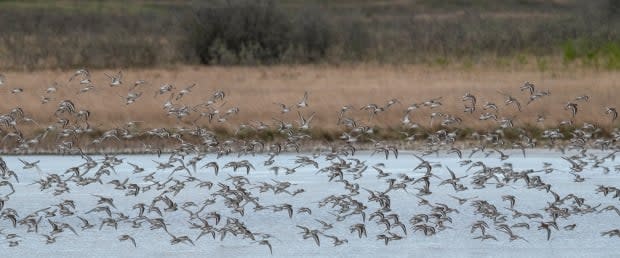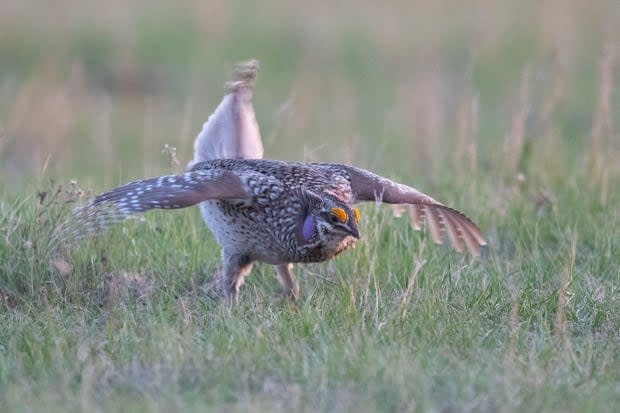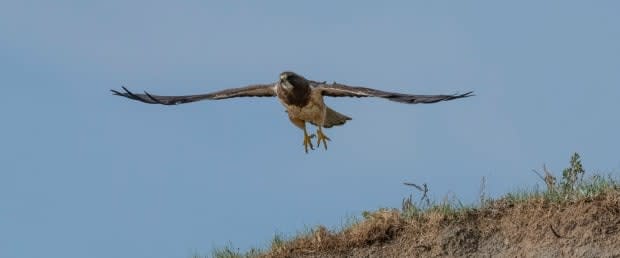A prairie hot spot for shorebirds is now a conservation site in Sask.

Chaplin Lake and its surrounding grasslands in southern Saskatchewan are an essential stop for migrating birds on their way to the Arctic.
To keep the space safe for travelling birds and other wildlife, this Prairie hotspot for shorebirds is now protected, according to the Nature Conservancy of Canada (NCC).
"If the habitat around Chaplin Lake would to be degraded or to be lost, there's a very good chance that it would displace all of those shorebirds that rely on that lake," said Michael Burak, program director in southwest Saskatchewan for NCC.
The conservation site, called the Mackie Ranch conservation project, includes a large section of native grassland as well as part of the eastern shoreline of Chaplin Lake, a few kilometres off the Trans-Canada Highway between Moose Jaw and Swift Current, according to the NCC.

The project received funding through the Government of Canada's Natural Heritage Conservation Program, part of Canada's Nature Fund, according to the NCC.
Grasslands are among the most at-risk ecosystems in the world, according to the national conservation organization. They filter water, help prevent flooding as well as droughts and sequester carbon.
The province has already lost over 809,000 hectares of native grassland during the last 25 years, said the NCC. Today less than 20 per cent are still intact.
A major stop for migrating birds
Thousands of shorebirds stop in the area to refuel or nest during spring and fall migrations, the national non-profit organization said.
In addition, Chaplin Lake is the second largest saline lake in the country, and the space is within the boundaries of the Chaplin-Old Wives-Reed Lakes Western Hemisphere Shorebird Reserve Network, according to the NCC.
"This site is one of only three in Canada with the designation of hemispheric importance to shorebirds," said the organization in a media release.
It is "the only site that is located inland."

Other areas in Canada with a similar volume of shorebirds are usually on the coast, according to Burak.
While a number of birds choose the coast as their migration part, others will travel from the Gulf of Mexico and central South America up the middle of the continent toward the Arctic, called the mid-continental flyway, said the program director.
"There's a certain number of lakes that have just the right kind of habitat and the right amount of food for that number of birds," said Burak.
"Chaplin Lake, just with it being so salty, has really high levels of different types of aquatic invertebrates."

The grasslands and wetlands provide a safe haven for migratory shorebirds, including half of the world's population of sanderlings, which stop there to feed and rest in the spring, according to the NCC.
Semipalmated sandpipers, Baird's sandpipers, red knot and piping plovers are some of the other winged visitors that stop by during their migratory journeys.
With enough food available for them at the Saskatchewan lake, the animals can stock up before finishing their journey to the north.
Home to Saskatchewan's provincial bird
Due to its 646 hectares of land, the Mackie Ranch property feels like a remote and isolated place, despite its closeness to Highway 1.
"It's a very strange thing to go out there," said Burak.
"All you see to the West is Chaplain Lake itself, just a big expansive open water, and then to the south is native grassland cut pretty much as far as the eye can see. And then you're kind of all surrounded on all sides by ranches and family farms."
WATCH | NCC's Mackie Ranch Property on YouTube:
According to the land conservation organization, the now-protected site is a habitat for animals listed under Canada's Species at Risk Act, such as the threatened ferruginous hawk.
Saskatchewan's provincial bird — the sharp-tailed grouse — also calls the area home, which has at least two active mating leks, said the NCC.
This is where the grouses gather in the springtime and the males dance to show off to the females, said Burak.
"If a coyote comes by or if a bird flies over, they'll all just freeze in place for a couple of seconds," he said.
"Then they go right back to dancing after that."

The new conservation site has been named after the Mackie family to recognize their stewardship of the land, according to the NCC, and cattle will continue to graze the area in order to keep the grasslands healthy.
In southwestern Saskatchewan partnerships between the NCC and local ranchers are very common, said Burak.
"They are very, very important to us," he said.
"I really don't think we have any land, at least in southwest Saskatchewan, where we don't have some type of a partnership with a nearby landowner or the previous landowner to continue managing that land for the benefit of biodiversity."



